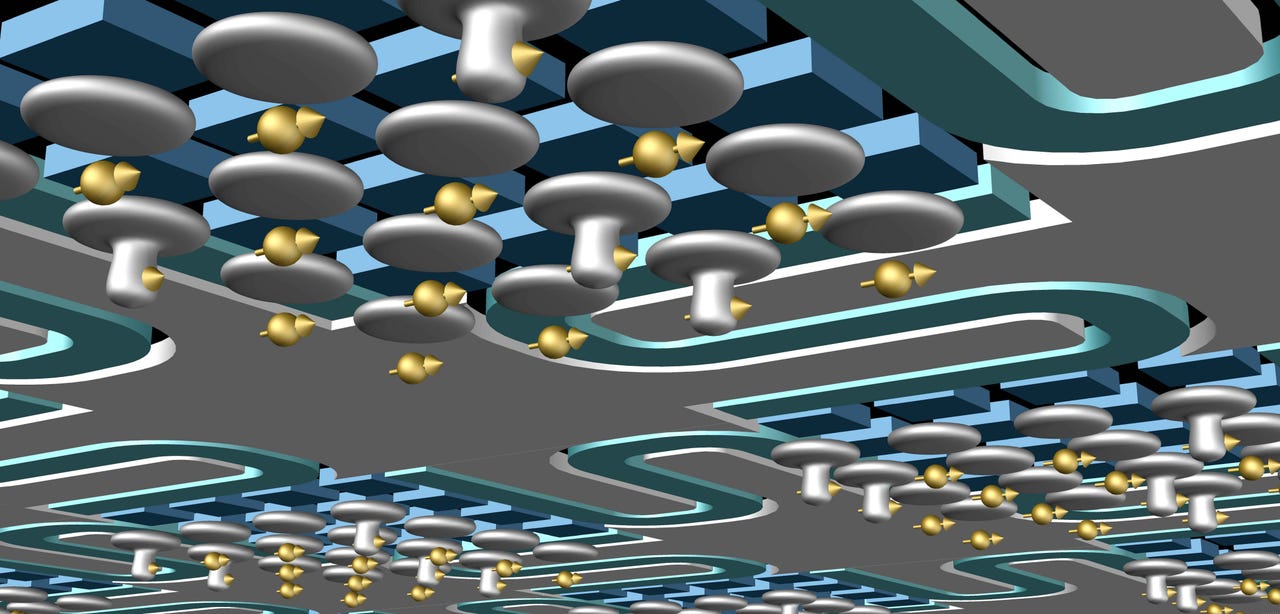Flip-flop qubits: UNSW conceives 'radical' quantum computing design


Flip-flop qubit processor illustration
Engineers at the University of New South Wales (UNSW) have announced the invention of a "radical" architecture for quantum computing, essentially allowing quantum bits (qubits) -- the basic unit of information in a quantum computer -- to be placed hundreds of nanometres apart and still remain coupled.
The invention is based on novel "flip-flop qubits" that UNSW said promises to make the large-scale manufacture of quantum chips dramatically cheaper and easier.
To operate the flip-flop qubit, researchers need to pull the electron away from the nucleus, using the electrodes at the top; doing so creates an electric dipole. The electric dipoles then interact with each other over fairly large distances -- a good fraction of a micron, or 1,000 nanometres -- meaning researchers can now place the single-atom qubits much farther apart than previously thought possible
The conceptual breakthrough is the creation of an entirely new type of qubit using both the nucleus and the electron. The new chip design allows for a silicon quantum processor that can be scaled up without the precise placement of atoms required in other approaches.
It was conceived by a team led by Andrea Morello, a professor of quantum engineering at UNSW and also the Program Manager in UNSW-based ARC Centre of Excellence for Quantum Computation and Communication Technology (CQC2T), who was instrumental in unlocking the key to enabling quantum computer coding in silicon in late 2015.
"It's a brilliant design, and, like many such conceptual leaps, it's amazing no one had thought of it before," Morello said of the flip-flop qubit progress.
Developing the concept alongside Morello was Guilherme Tosi, a Research Fellow at CQC2T, as well as a team comprised of Fahd Mohiyaddin, Vivien Schmitt, and Stefanie Tenberg of CQC2T, and collaborators Rajib Rahman and Gerhard Klimeck of Purdue University in the United States.
"What Guilherme and the team have invented is a new way to define a 'spin qubit' that uses both the electron and the nucleus of the atom," Morello explained. "Crucially, this new qubit can be controlled using electric signals, instead of magnetic ones. Electric signals are significantly easier to distribute and localise within an electronic chip."
According to Tosi, the new design sidesteps a challenge that all spin-based silicon qubits were expected to face as teams begin building larger and larger arrays of qubits, which is the need to space them at a distance of only 10 to 20 nanometres, or 50 atoms, apart.
"If they're too close, or too far apart, the 'entanglement' between quantum bits -- which is what makes quantum computers so special -- doesn't occur," Tosi added.
As researchers at the university want to make an array of millions of qubits very close together, Morello explained that all of the control lines, control electronics, and readout devices must also be fabricated at a nanometric scale. The flip-flop qubit enhancement means the researchers have another pathway to pursue their goal of winning the quantum race.
In the single-atom qubit used by Morello's team, and which Tosi's new design applies, a silicon chip is covered with a layer of insulating silicon oxide, on top of which rests a pattern of metallic electrodes that operate at temperatures near absolute zero and in the presence of a very strong magnetic field, UNSW explained.
At the core is a phosphorus atom, from which Morello's team has previously built two functional qubits using an electron and the nucleus of the atom. These qubits, taken individually, have reportedly demonstrated world-record coherence times.
Following the advancements UNSW achieved in quantum computing, the federal government allocated AU$26 million of its AU$500 million science funding to support its work in quantum computing, made available under Australia's AU$1.1 billion National Innovation and Science Agenda.
Within 48 hours of the cash injection from the federal government, the Commonwealth Bank of Australia (CBA) pledged AU$10 million over five years to support the university's researchers, and Telstra then matched the bank's efforts, also pledging AU$10 million over five years, to boost UNSW's capacity to develop the world's first silicon-based quantum computer.
In July, the New South Wales government similarly announced a AU$26 million fund it hopes will "supercharge" the development and commercialisation of quantum technologies.
The UNSW team also struck an AU$83 million deal between UNSW, Telstra, CBA, and the Australian and New South Wales governments to develop, by 2022, a 10-qubit prototype silicon quantum integrated circuit.
In August, the partners launched Silicon Quantum Computing Pty Ltd, Australia's first quantum computing company, to advance the development and commercialisation of the team's technologies.